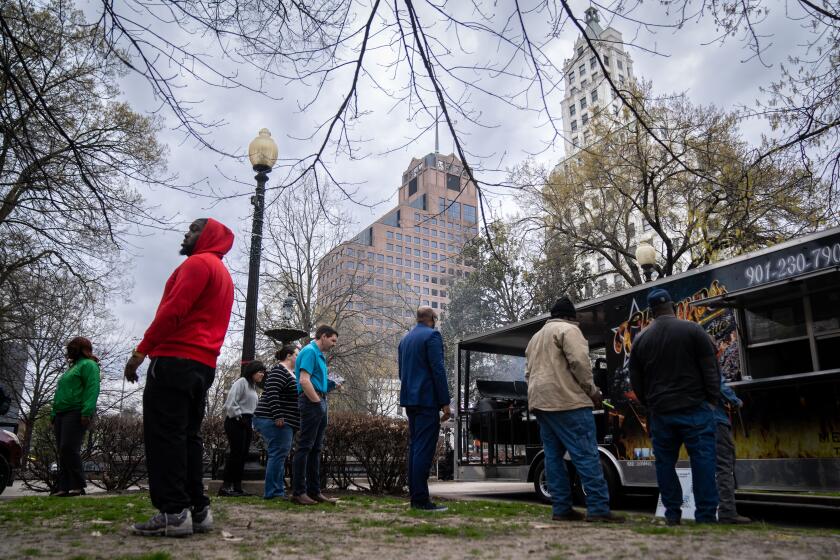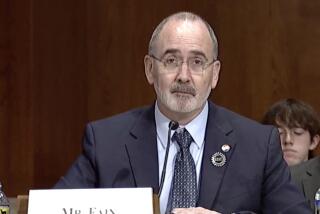Working from home becomes a once-a-week perk for some office goers

- Share via
A small but growing list of big-name companies including BlackRock, Walt Disney and Chipotle Mexican Grill are taking their return-to-office mandates up a notch, calling employees back to their desks four days a week.
It’s a form of RTO creep, as companies test what has emerged as the post-pandemic norm of two to three days in the office and fan the debate over remote work. It’s also a sign of employers gaining more power in the labor market as layoffs mount and a potential recession looms.
As the Great Resignation took hold, quit rates soared and staffing shortages hamstrung businesses, companies were forced to embrace flexibility to keep workers. Now a cooling labor market has emboldened executives determined to get back to a semblance of pre-pandemic normalcy. But these moves could backfire among employees who’ve grown fiercely protective of the work-life balance that remote work affords.
Among the companies instituting more aggressive RTO policies, Chipotle ratcheted up its on-site requirement to four days a week last month from three since March. Disney made its four-day move, up from two or three previously, shortly after the return of Chief Executive Bob Iger. BlackRock has said employees must be in the office four days a week starting in September, after nearly two years mandating three days on-site. Snap and top law firms such as Davis Polk and Skadden also have broken ranks to require four days. JPMorgan Chase, meanwhile, has ordered managing directors back to the office five days a week.
Other companies may be watching to see how these policies play out as they consider their own.
Smaller and cheaper towns and counties across the nation are competing to lure higher-income workers from California and other costly places.
“I wouldn’t be surprised if some organizations take their peers’ lead if they wanted to increase the frequency of on-site work,” said Caitlin Duffy, research director in the human resources practice at consulting firm Gartner Inc. “They may have not wanted to be an outlier.”
At the same time, many workers have made major life changes around their hybrid work policies, rearranging things such as child care to where they live.
“Going back on something that influential to day-to-day life for employees — and not just in work life, but also their life more holistically — this causes so much disruption,” Duffy said.
Employees have voiced fierce opposition through public protests at companies including Amazon.com , Starbucks and Disney. At Disney, more than 2,300 employees signed a petition urging reconsideration of the policy, saying the mandate will result in “forced resignations among some of our most hard-to-replace talent and vulnerable communities” while “dramatically reducing productivity, output, and efficiency.”
Two or three days a week is the sweet spot for employee engagement and well-being, according to a Gallup survey of more than 16,000 full-time U.S. employees conducted last year. Its data also show that remote-capable employees who don’t work in their preferred location are more prone to burnout and a desire to quit.
Love remote work? Here are expert tips for how to negotiate a permanent work-from-anywhere arrangement with your boss.
This emerging norm is also reflected in data from WFH Research, a group of experts from Stanford University, the Massachusetts Institute of Technology, the University of Chicago and other institutions, that show workers’ desire and employers’ plans for the average number of days worked remotely has stabilized at somewhere between two and three days a week.
Though companies that increase their in-office requirements might not see an immediate exodus — switching jobs takes time — it might be the line at which employees start looking, Duffy said. Roughly 1 in 2 people who work in finance would change jobs — or already have — if their managers required them to spend more time in the office, according to a Bloomberg Markets Live Pulse survey in early June.
While four-day-a-week mandates have made headlines and may provide some cover for other companies who want to do the same, they’re still rare, according to Scoop Technologies’s Flex Index, which tracks the remote work policies of more than 4,500 companies. Of hybrid companies that require a minimum number of days in the office, only about 5% mandated four days as of early June, according to Scoop. Two or three days remains the norm, accounting for roughly 90% of hybrid setups.
The call for more in-office time comes as other companies make clear that their existing mandates are compulsory and have started enforcing them — or at least indicating working from home isn’t the best way to get ahead. Google announced last week it will include in-office attendance in performance reviews while International Business Machines CEO Arvind Krishna has said that not showing up will hurt employees’ chances of promotion.
The rationale for returning to in-person work includes what many company leaders see as greater opportunities for learning, career development and mentorship. “The key driver behind our in-office attendance philosophy is a desire to provide all members of our community with best-in-class professional development opportunities,” Davis Polk managing partner Neil Barr wrote in an internal email seen by Bloomberg.
A return to in-person work might seem like a good thing. But some red-state leaders worry the return-to-work economy will limit their talent pool.
Recent research from economists at the Federal Reserve Bank of New York, the University of Iowa and Harvard University provides some backing for this view: The paper, titled The Power of Proximity, argues that working in the same building “has an outsized effect on workers’ on-the-job training,” especially for younger workers. Data from WFH Research show that those in the office spend 25% more time on career-development activities than remote counterparts.
For Disney, face time is seen as necessary for creativity: “In a creative business like ours, nothing can replace the ability to connect, observe and create with peers that comes from being physically together,” Iger said in an internal memo seen by Bloomberg. Others, like Chipotle, cite ambitious business objectives as a driving factor: The company’s moving to a Monday through Thursday schedule “to preserve our unique, collaborative culture and achieve our aggressive growth plans,” Laurie Schalow, Chipotle’s chief corporate affairs officer, wrote in a statement to Bloomberg.
For employees who value flexibility and have proved they can get their work done outside the office, the shift to four days can feel like a rollback of autonomy and trust. The policy removes a key element of choice, since most organizations that mandate four days expect attendance Monday through Thursday.
“It’s frustrating for employees because they’ve already been working really hard and performing really well, and so it almost feels like a negative — they’re saying, ‘Well, that’s not good enough,’ or that we don’t trust you to continue in this way,” Gartner’s Duffy said.
Duffy advises executives to carefully consider what they’re trying to achieve with in-office requirements and to be intentional about that, beyond just mandating a set number of days.
From yoga classes to musical performances, landlords are trying to woo back workers who left office space vacant during the pandemic.
“‘What do you really want from your hybrid model?’ is a question I always ask every leader who’s grappling with this kind of decision. What outcomes are you trying to drive?” she said. “If the outcome is just, ‘make your leaders happy because they want employees on-site,’ that might not be necessarily the best rationale.”
Bloomberg writer Matthew Boyle contributed to this report.
More to Read
Inside the business of entertainment
The Wide Shot brings you news, analysis and insights on everything from streaming wars to production — and what it all means for the future.
You may occasionally receive promotional content from the Los Angeles Times.














